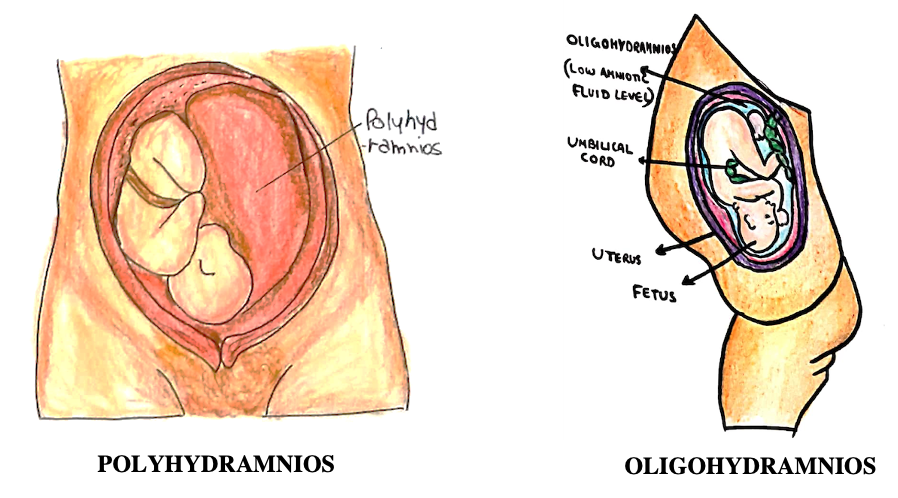Back to: Obstetrics
Oligo/Polyhydramnios
Oligohydramnios
This is the term used to describe an abnormally low level of amniotic fluid during pregnancy
– It is characterised by having less than <500ml at 32-36 weeks and amniotic fluid index (AFI) <5th percentile
– It can lead to abnormal foetal presentations and underdevelopment of foetal parts
Causes:
– Low production of foetal urine –> Renal agenesis (Potter’s syndrome), dysplastic kidney, obstructive uropathy
– Poor Placental diffusion –> Pre-eclampsia
– Leakage of amniotic fluid –> Premature rupture of membranes
Complications:
– Abnormal lie and development
– Poor respiratory development –> amniotic fluid is needed for maturation of the alveoli, so infants are born with severe respiratory distress
– Foetal muscle contractures (as amniotic fluid allows the fetus to move its limbs in utero)
Diagnosis:
– Ultrasound is investigation of choice (shows level <5th centile)
Management:
– Increase maternal hydration (+ amniofusion during labour to stop cord compression)
Polyhydramnios
This is the term used to describe an abnormally high level of amniotic fluid during pregnancy
– It is used when the amniotic fluid index is above the 95th centile for gestational age
– It causes over-distension of the uterus which can lead to preterm labour and other complications
Causes:
– It is idiopathic in the majority of cases
– Congenital infection
– Twin-to-twin transfusion syndrome –> leads to oligohydramnios for one and polyhydramnios for the other
– Decreased swallowing of fluid –> foetal oesophageal/duodenal atresia or CNS abnormalities
– Increased production of fluid:
– Macrosomia (big babies produce more urine)
– Maternal lithium ingestion (leads to foetal diabetes insipidus)
– Adenomatoid malformation of the lung which leads to increased foetal lung secretions
Complications:
– Preterm delivery (due to over-distension of the uterus)
– Malpresentation (fetus has more room to move within the uterine cavity) increasing risk of breech delivery
– Post-partum haemorrhage (as the uterus has to contract move to compress the dilated blood vessels)
– Gastro-oesophageal reflux for the mother
Diagnosis:
– Ultrasound is investigation of choice (shows level >95th centile)
Management
– Antacids to relieve heartburn and nausea for the mother, monitor complications for fetus




